

Ohio Soybean News
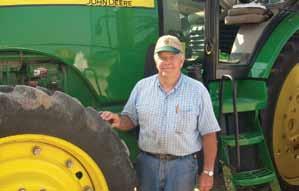

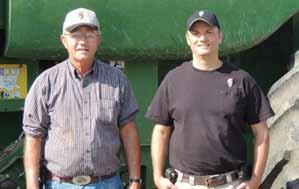
Tom Flora – Delphi, Indiana
Kaffenbarger Farms – New Carlisle, Ohio
Ohio Soybean News



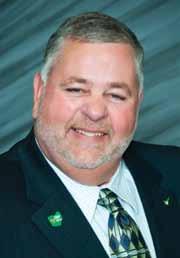
Bret Davis
Ohio Soybean Association Chairman
Delaware County soybean farmer
A Letter From the Chairman
By the time you receive this, I hope Ohio is experiencing warmer temperatures that will set farmers up for good planting conditions in the coming months.
The Ohio Soybean Association (OSA) Board of Trustees recently represented Ohio soybean farmers in developing the American Soybean Association (ASA) policy direction for the next year at the 2014 Commodity Classic held in San Antonio, Texas. OSA brought many ideas to the table that were adopted by the national leadership.
One policy involves the Occupational Safety and Health Administration (OSHA). ASA and OSA recognize the need to improve farm safety, but oppose any attempt by the Department of Labor to expand OSHA to include farms with less than 10 employees.
Also considered a priority for OSA and ASA is the recent tax reform proposal which includes wins and challenges for soybean farmers. OSA strongly supports the measures proposed to allow farmers to continue utilizing cash-based accounting regardless of size. This accommodates the uncertain and potentially inconsistent nature of farm incomes and crop values across multiple years. OSA also supports the proposed increase in revenues for investment in our waterways and highway transportation infrastructure. One remaining concern involves the proposal’s elimination of the Biodiesel Tax Credit. The Biodiesel Tax Credit provides many benefits including jobs, economic development, diversity in our energy sources and reduction to greenhouse gas emissions. OSA continues to represent Ohio soybean farmers at the state and national level and will continue lobbying on members behalf.
I would also like to remind all OSA members to consider submitting an application or nominating someone for the Beck’s Young Farm Leader Program. OSA has partnered with Beck’s Hybrids to recognize Ohio soybean farmers and their involvement with the industry. You can apply online at www.soyohio.org/becksyoungfarmleader or nominate someone by contacting Adam Ward at award@soyohio.org. This is the second year of the program and there are still three more quarters and many eligible soybean farmers in Ohio that should be recognized. One of the Beck’s Young Farm Leaders will be selected as the 2014 Beck’s Young Farm Leader of the Year and receive a trip for two ($2,000 value) to the 2015 Commodity Classic in Phoenix, Arizona.
I hope you have a safe and productive planting season.
SOYBEAN ASSOCIATION
President
Jerry Bambauer, Auglaize County
Chairman
Bret Davis, Delaware County
First Vice President
Tom Price, Putnam County
Vice President
Mike Heffelfinger, Van Wert County
Treasurer
Jeff Roehm, Highland County
Secretary
Adam Graham, Logan County
Trustees
Allen Armstrong, Clark County
John Buck, Marion County
Amy Sigg Davis, Warren County
Dave Dotterer, Wayne County
Caitlyn Heimerl, Licking County
James Heimerl, Licking County
Todd Hesterman, Henry County
Chad McIlvaine, Ross County
Lane Osswald, Preble County
Bruce Simmons, Medina County
Bob Slicker, Stark County
Jeff Sollars, Fayette County
Industry Affiliates
Kathy Alvarez, Bunge N.A.
Bill Tom, Trupointe Cooperative
American Soybean Association Board
Representatives
Bret Davis
Jerry Bambauer
Jeff Sollars
Staff Credits
Adam Ward – Publisher
Jennifer Coleman – Editor
Katie Bauer – Staff Writer
Judy Brent – Production Manager
Carol Locker – Designer
Ohio Soybean News is published six times a year by the Ohio Soybean Association, 918 Proprietors Rd., Suite A, Worthington, OH 43085 Phone: 614-476-3100. For address corrections contact Ohio Soybean News at 918 Proprietors Road, Suite A, Worthington, Ohio 43085. Web address: www.soyohio.org E-mail: cdeboard@soyohio.org

Comments and statewide news articles should be sent to the above address. Advertising space reservations must be made by the first of the month preceding publication. In consideration of the acceptance of advertisement, the agency and the advertiser must, in respect of the contents of the advertisement, indemnify and save the publisher harmless against any expense arising from claims or actions against the publisher because of the publication of the content of the advertisement.
For Advertising Information Call: Tom Shearing
Advertising Sales Manager
Phone: 585-476-2426



We’re helping you write a better end to this story.
We’re investing your soybean checkoff dollars to build awareness among businesses and organizations about deteriorating transportation infrastructure like Ohio’s lock and dam system. These systems are vital to your ability to transport your soybean crop and affect profitability and international demand.




©2013, Ohio Soybean Council
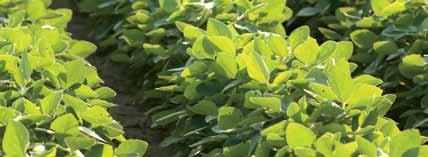
SOY TALK
A Market View
At this time of year, most farmers are anxiously looking forward to the preparations required for putting the 2014 crop in the ground. While those efforts are necessary, now isn’t the time for farmers to neglect marketing the crop that may still be in the bin.
Soybean production in 2013 totaled 3.29 illion bushels, up eight percent from 2012. Dow AgroSciences grain leader Larry Stenberg says soybean carryover as of Aug. 31, 2014 is forecast to be at 150 million bushels, which is tight and why the market is inverted. However, only about two-thirds of the 2013 soybean crop has been sold. With large soybean crops expected in both Argentina and Brazil and anticipated soybean acreage increases in the United States, the stage is set for prices to continue a downward trend.
Stenberg says a strong crop in Argentina and an anticipated record crop in Brazil could encourage buyers like China to cancel U.S. soybean orders and buy elsewhere to get lower cost beans. Cancelling orders would surely drive U.S. prices down.
“Now isn’t the time for farmers to neglect marketing the crop that may still be in the bin.” b
Long term, Stenberg is bearish on beans. He says many farmers are in denial about the trend in crop prices.
“My biggest fear is that we plant 91 million acres of corn and 81 million acres of soybeans and by July, American farmers will still have large volumes of the 2013 crop unsold and very little of the 2014 crop,” Stenberg says. “If we get a normal crop year, then farmers will have to sell what they produced last year and many will have done nothing about this year’s crop. It’s a giant vacuum that pulls prices down.”
Many trend lines point to soybean prices heading down, with November 2014 beans right around $11 per bushel. If U.S. carryover stocks double to 300 million bushels as some anticipate, beans could drop as low as $9 by next November.
Stenberg points to wildcards such as South American weather and yields, domestic demand and exports, China’s demand for soybeans, EPA’s impact on the Renewable Fuels Standards (RFS) as factors that could dramatically impact the price of corn and soybeans in the coming year.
He advises that farmers should be ready to sell when markets dictate. “Farmers need to be selling old crop rallies, and new crop, sell on the bounces. Don’t be the last one to the party, go out and market your crop.”
New OSA Member Wins 50 Hours with Challenger Tractor
By Jennifer Coleman
The Ohio Soybean Association (OSA) and Ohio Ag Equipment recently announced that Chris Pugh won 50 hours with an MT600 Series Challenger tractor. This promotion allowed all new OSA members who signed up by March 1 to be entered in a drawing to win free hours with the tractor. Chris’s name was selected last week during the 2014 Commodity Classic in San Antonio, Texas.
“I would like to thank OSA and Ohio Ag Equipment for offering this exciting promotion to new members,” said Pugh. “I believe being a member of OSA offers many advantages to the current and future generations of Ohio soybean farmers.”
Taking this and other opportunities to promote the work it does on behalf of its members is extremely important to OSA.
“I want to congratulate Chris on winning the tractor which was only possible thanks to the great partnership we have with Ohio Ag Equipment,” said Jerry Bambauer, OSA president and soybean farmer from Auglaize County. “Ohio soybean checkoff dollars cannot legally be used to lobby, so it is vital that all Ohio soybean farmers sign up to be a member of OSA. We work on the legislative issues that are most important to you, but without your support, we can’t continue that work.”
In addition to OSA’s partnership with Ohio Ag Equipment for new members, OSA offers a variety of membership incentives including the Seed Incentive Program, biodiesel rebates, discounts at participating companies and subscriptions to Ohio agriculture publications. All OSA members automatically become members of the American Soybean Association and receive those benefits as well.
Brought to you by:
“We would like to congratulate Chris on winning the use of an MT600 Challenger tractor,” said Kelly Love, Vice President of Ohio Ag Equipment. “We at Ohio Ag Equipment are dedicated to enhancing our partnership with Ohio agriculture and are happy to support the Ohio Soybean Association.”
To learn more about OSA membership and to sign up, visit www.soyohio.org/membership today! u

Ohio Soybean Association Celebrates 2014 Farm Bill Passage
By Katie Bauer
After advocacy by the Ohio Soybean Association (OSA), American Soybean Association (ASA) and other farm groups, the time and energy paid off as the passage of the Agricultural Act of 2014, most commonly called the farm bill, brought relief to many farmers across the United States.
The bill includes a choice between a revenue program that covers both price and yield losses with county and farm level options, and a price support program, which allows the optional purchase of insurance coverage under a Supplemental Coverage Option (SCO).The bill also eliminates Direct Payments while maintaining decoupled farm support programs that will minimize the possibility of plant-
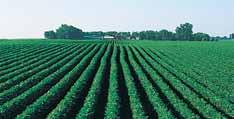
ing and production distortions that could trigger new challenges from the World Trade Organization.
In addition to the risk management framework, the bill also secures several other OSA and ASA priorities: agricultural research programs, including the Agriculture and Food Research Initiative (AFRI) and the new Foundation for Food and Agriculture Research (FFAR);

I will know my weeds. When they grow. When they pollinate. And I will stop them before they go to seed.

I will take action in the field and do whatever it takes to give my crops the upper hand against weeds.

I will take action with careful herbicide management and use multiple herbicide sites of action, because every action counts.
I will take action because it’s my bottom line. It’s not about this year or the next. It’s about the long term.
I will take action. This time. For all time.
Now is the time to take action against herbicide-resistant weeds. Visit www.TakeActionOnWeeds.com to learn how you can prevent herbicide-resistant weeds from spreading.

export promotion done under the Foreign Market Development (FMD) and Market Access Program (MAP) on which soybeans depend as the nation’s top farm export; and key energy programs, including the Biodiesel Education Program and a strengthened Biobased Markets Program. Additionally, the bill consolidates 23 previous conservation programs into 13, while focusing conservation efforts on working lands.
“Soybeans are an important part of Ohio’s economy and the top agricultural export for the state,” said Jerry Bambauer, OSA president and soybean farmer from Auglaize County. “The farm bill will provide market stability and certainty for Ohio soybean farmers.”
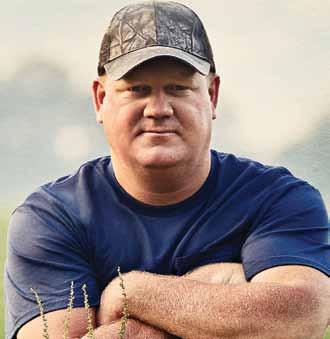
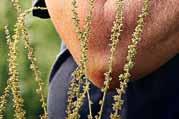

Benefits of the 2014 Farm Bill
Provides an adequate and flexible farm safety net, including improvements to crop insurance and a choice between price-based and revenue-based risk management tools. Includes a revenue program which covers both price and yield losses, with county and farm level options, and a price support program which allows the optional purchase of insurance coverage under Supplemental Coverage Option (SCO).
Reforms Title I support by eliminating controversial Direct Payments while maintaining decoupled farm support programs (both price and revenue) that will minimize the possibility of planting and production distortions that could trigger new WTO challenges.
Allows producers to either maintain existing crop acreage base or to reallocate their current base to reflect average acres planted to covered commodities in 2009-2012 – a
reform that will make programs more relevant and more defensible while not tying them to current-year plantings. Also allows producers to update payment yields.
Strengthens crop insurance by making enterprise units permanent, authorizing a new Supplemental Coverage Option (SCO), and providing a 10 percentage point increase in premium support to beginning farmers and ranchers.
Consolidates 23 previous conservation programs into 13, and focuses conservation efforts on working lands.
Maintains authorizations for important agricultural research programs, including AFRI, as well as including a new Foundation for Food and Agriculture Research (FFAR) which will provide a structure and mandatory funding for new public/private partnerships and investments that will fur-
ther USDA’s research mission.
Maintains authorizations and funding levels for export promotion, including the Foreign Market Development (FMD) Program and the Market Access Program (MAP).
Provides nearly $900 million in mandatory funding for key energy programs, including the Biodiesel Education Program and a strengthened Biobased Markets Program.
Continues the combined authorization of both agricultural and nutrition programs, a linkage that has been essential in enacting every farm bill since 1974.
Achieves net savings of $24 billion over ten years, primarily from the elimination of Direct Payments, making agriculture the only sector that has contributed to deficit reduction in the 113th Congress. u
Leveraging Resources at Your Fingertips
During these winter months, it is important to set aside time to start thinking about plans for the upcoming growing season. There are several things for soybean farmers to think about, but two important topics that should not go unnoticed are thinking about managing marestail and preventing Palmer amaranth. Mark Loux, OSU extension specialist, weed science, encourages farmers, “For consistent control of marestail, it is important farmers understand the rationale for their program.” There are resources available to help in making the best management decisions this winter. One resource is the marestail fact sheet, “Control of Marestail in No-till Soybeans,” that can be found online on Ohio State Extension’s website.

Palmer amaranth is another topic farmers should be concerned about. Loux continues, “Palmer amaranth is extremely aggressive and can take over a field.” OSU Extension has also developed a “Pigweed I.D.” poster to help farmers identify Palmer amaranth if they believe it is present in their field. These are just a few topics farmers should keep on their mind as we enter another growing season. It is important to remember resources like OSU Extension that can help with any questions related to soybean production.
Managed by the Ohio Soybean Council and soybean checkoff, the Soybean Rewards Program helps Ohio soybean farmers increase productivity, yield and profitability by providing information and research related to premium opportunities, new varieties, disease and pest management and conservation practices.
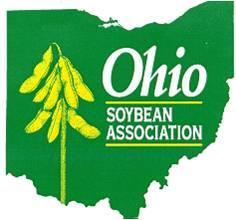
Advocacy
Checkoff Dollars Cannot Be Used to Lobby


2014 Ohio Soybean Association Member Benefits
• 10% discount on one-time purchase at Tractor Supply Company†
• 10% discount on all in-stock merchandise & 20% off safety items at any participating JD Equipment locations †
• Rebate coupon for $.05/gallon up to 2,000 gallons of soy biodiesel†
• Subscription to Ohio’s Country Journal*†
• 6 issues of the Ohio Soybean News magazine*†
• 9 issues of the Ohio Leader Letter — OSA’s memberonly newsletter*†
• NEW MEMBERS: Discounted subscription of $20 to Fastline Publications*†
† 3-year membership incentive *1-year membership incentive
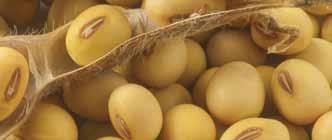
2014 American Soybean Association Member Benefits
When you join OSA, you will also become a member of the American Soybean Association and enjoy these additional benefits.
• Affinity Center International, “Achieve Links” Program — earn reward points redeemable at more than 1,200 vendors, www.soygrowers.com
• National Biodiesel Board – Ford Partner Recognition X-Plan Vehicle Pricing Program — exclusive savings on eligible Ford and Lincoln vehicles
• National Biodiesel Board – Chrysler Affiliate Reward Program — preferred price of 1% below factory invoice on the purchase or lease of most new Chrysler, Dodge or Jeep vehicles
• National Biodiesel Board — GM Supplier Discount Program – exclusive savings on eligible GMC, Chevrolet, Buick and Cadillac vehicles
• SOY Scholarship — children and grandchildren of ASA members are eligible to compete for the $5,000 Secure Optimal Yield Scholarship, www.soygrowers. com/soy/scholarship.htm
• Cabela’s gift cards — 10% discount through a special link on www.soygrowers.com u
Ohio Soybean Association Membership Application
Name:
Farm/Company:
Address:
City:
State:
Zip:
County:
Phone:
Fax:
Email:
Payment Information: 3-year ($205) 1-year ($80) Lifetime Membership ($1,000)
Check this box if you do not want your membership dues to go toward the Ohio Soybean Political Action Committee ($5 for 1-year and $10 for 3-year).
Check enclosed payable to: Ohio Soybean Association
Credit Card VISA MASTERCARD
Card No.__
Exp. Date
Recruited By:
Mail to: Ohio Soybean Association 918 Proprietors Road, Suite A Worthington, OH 43085


Ryan Rhoades of Marion County Named Beck’s Young Farm Leader
By Katie Bauer
Just north of Delaware County lies Rhoades Farms where Ryan Rhoades operates a grain and livestock operation alongside his father, Wendell, mother, Janet, wife, Amanda and full-time employee, Dave Peterson.
Ryan, a third generation farmer, was recently selected as the first quarter winner of the 2014 Beck’s Young Farm Leader Program. Currently in its second year, the Beck’s Young Farm Leader Program is designed to showcase the hard work, dedication and leadership of young Ohio farmers.
“The Ohio Soybean Association (OSA) is proud to recognize Ryan and his involvement with the soybean industry,” said Jerry Bambauer, OSA president and soybean farmer from Auglaize County. “Through the Beck’s Young Farm Leader program, OSA and Beck’s Hybrids aim to recognize young Ohio farmers like Ryan who are committed to advancing the industry. We want all OSA members to encourage a young farmer in their community to apply for the Beck’s Young Farm Leader Program.”
Ryan discovered his passion for agriculture from a young age and went on to graduate from Wilmington College in 2002 where he studied Agriculture and Spanish. Until the winter of 2011, Ryan’s farm operated as an LLC. It was then that he joined his father’s operation to become Rhoades Farms in a general partnership. Together, they currently grow 2,300 acres of soybeans, corn and wheat rotation and manage a livestock operation in Marion County. The day-today operations are performed by Ryan and
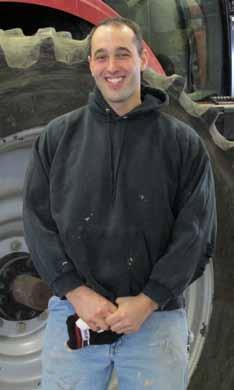
Dave with the grain marketing managed by Wendell. Janet and Amanda primarily handle all the book work to run the farm.
“It most certainly is a team effort for our farm and there is never a dull moment or not enough work to be done,” added Ryan. “I wouldn’t trade it for the world and am happy with the direction we decided to take on our operation two winters ago. Like any business, there have been some struggles, but I hope someday my children have the opportunity to farm.”
Ryan and his wife Amanda currently have three children, Hanah (7), Stone (4), Olive (2) and are expecting a fourth child in July.
Aside from family life and farming, Ryan is involved with Fite Memorial Baptist Church in Marion, Ohio and currently serves as county committee member for the Delaware County office of the Farm Service Agency. He believes there are many challenges and opportunities facing agriculture, and embracing change will be an important factor in whatever the future holds.
“One long-term goal would be to see soybean yields increase by embracing technology, production practices and research to gain a bigger spotlight in today’s cropping system,” said Ryan. “Soybeans are a challenging and unpredictable cash crop with huge potential in yield, exports and remain a strong protein source around the world.”
“I also think it’s important to address any public concerns about soybean farmers and how we produce our crop,” added Ryan. “With approximately three generations of America’s families removed from the farm, this will continue to be a growing issue. How we engage the public will be critical going forward.”
Beck’s Young Farm Leaders are chosen by a selection committee consisting of OSA and Beck’s Hybrids representatives.
“As we enter the second year of our partnership with OSA on the Beck’s Young Farm Leader program, we are excited to recognize Ryan Rhoades as the first quarter winner for 2014,” said Bruce Kettler, Director of Public Relations at Beck’s Hybrids. “One exciting aspect of the applications for this quarter is that we are seeing more applications and growing depth to the applicants. Ryan continues to exemplify the community involvement and dedication that the program intended to highlight.” u

Ryan Rhoades
2014 Beck’s Young Farm Leader Program
Apply or Nominate Someone Today!
If you or someone you know is interested in learning more or applying, visit www.soyohio.org/ becksyoungfarmleader. If you would like to nominate someone, please contact Adam Ward at award@soyohio.org.
The 2014 Beck’s Young Farm Leader of the Year will receive a trip for two ($2,000 value) to the 2015 Commodity Classic in Phoenix, Arizona.

Guidelines:
Growers must be between the ages of 21 and 45.
Any soybean grower may apply for the Beck’s Young Leader Program; selected participants are required to have a current Ohio Soybean Association membership.
Applicants are not required to grow Beck’s Hybrids products to be eligible to win.
Applicants should demonstrate an interest in pursuing leadership roles within the soybean industry.
I WILL REDUCE THE WEED SEEDS IN MY SOIL.
I will take action against herbicide-resistant weeds.

I will know my weeds. I will target their strengths and exploit their weaknesses.
Escapees don’t stand a chance.

I will seek them out and take them down before they go to seed.
Because fewer seeds today mean fewer weeds tomorrow. Preventing weed seed production is essential to weed management. Visit www.TakeActionOnWeeds.com to learn how you can prevent herbicide-resistant weeds from spreading.

All applications postmarked by the following dates will be considered. Applications will carry over to subsequent quarters for consideration, but will not carry over to the 2015 Beck’s Young Farm Leader Program.
May 1, 2014: 2nd Quarter Applications Due August 1, 2014: 3rd Quarter Applications Due October 31, 2014: 4th Quarter Applications Due
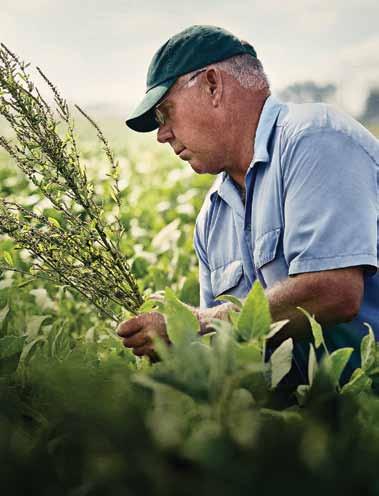


and affordable. Since no other agricultural
Why aquaculture in Ohio?
Global fish demand continues to increase leading to a growing aquaculture industry (60 m tons/year, 2010).
Global fish consumption has nearly doubled in the last 40 years.
Wild fish capture has leveled off due to decreasing wild stocks and high scrutiny.


Why do soybeans & fish farming go together?






By replacing a percentage, or all, of the fish meal with soybean meal, aquaculture becomes more sustainable, both economically and environmentally.
Soybean meal costs less than most animal meals, including fish meal.
Soybean meal provides a consistent product to fish farmers, which allows consistent quality, size, and supply of fish and shrimp in the value chain.
Fish require less feed per pound of meat produced than any other food consumption animal.
Soy based aquaculture feed information: www.indianasoybean.com role within this emerging market.
What’s happening in Ohio?
Research funded by the Ohio Soybean Council is focused on higher utilization of soybean meal. A few of the research projects are:

Removing anti-nutritional carbohydrates from soybean meal to improve the health and growth of fish.

Developing analytical methods to determine the amount of anti-nutritional carbohydrates present within fish feed.


Identifying processing techniques to prepare different kinds of fish feed.
Determining the impact of soybean meal on aquaculture production and food safety.

Conducting research to breed perch that will eat more soybean meal and have improved growth.
Ohio farms:
In 2012, 216 farms had aquaculture permits, a 25 percent growth since 2010.
87 percent of aquaculture farms in Ohio plan to maintain or expand production in the next five years.









Investing Checkoff Dollars
Columbus Will Host Bioproducts World Showcase and Conference Oct. 5-8
The Bioproducts World Showcase and Conference — a firstof-its-kind event to accelerate the manufacturing, distribution and use of bio-based products — will be held Oct. 5-8 at the Greater Columbus Convention Center and Hilton Hotel in downtown Columbus, Ohio.
Presented by the Ohio Bioproducts Innovation Center (OBIC) at The Ohio State University, the event will bring together leaders from across the emerging bio-based products industry to support consumer and corporate demand for these products, facilitating business relationships and contracts.
The conference program has been designed to emphasize procurement, product manufacturing, and bio-based feedstocks, with each session featuring professional speakers. Manufacturers will have the opportunity to showcase the virtues of their bioproducts with target market buyers and procurement officials, said OBIC Director Dennis Hall.
“Our market research indicates that consumers would purchase bio-based products if more were available,” Hall said. “The Bioproducts World Showcase and Conference will facilitate the type of commercialization activities that increase awareness and speed the adoption of bioproducts.”
Success in the bioproducts industry starts with knowing your customers, Hall said. OBIC will focus on the needs of both public procurement officials and com-
mercial buyers at this event to advance the marketing of a range of bio-based products.
“The Ohio Soybean Council (OSC) and soybean checkoff has long supported the bioproduct industry, specifically soybased bioproducts,” said Keith Roberts, chair of the OSC New Uses committee and soybean farmer from Marion County. “Today, you’ll find soy-based bioproducts in everything from cleaning products to carpet backing, paint to foam for auto seats and furniture, ink toner and skin care products. The Bioproducts World Showcase and Conference is a great opportunity to highlight and advance the soy bioproduct industry.”
To learn more about the Bioproducts World Showcase and Conference and register, visit www. bioproductsworld.org. u Biobased Product Manufacturers
What?
The inaugural Bioproducts World Showcase & Conference will be held October 5-8, 2014 in Columbus, Ohio.
The Ohio Bioproducts Innovation Center at The Ohio State University will host the Showcase. OBIC seeks to promote the biobased materials and products industry. While OBIC has historically promoted the industry through cluster development strategies to accelerate bioproducts commercialization, it is now expanding through this new event in 2014.
Why?
Showcase innovative, biobased products in a single event for key decision makers and procurement officials from commercial and government entities
Features of the event will include educational sessions with industry experts and a trade show showcasing the future of the bioproducts industry.
Benefits to exhibiting and/or attending:
• Strengthening of the biobased industry for increased growth of stable jobs.
• Leveraged and expanded market opportunities among suppliers, purchasers, and entrepreneurs.
• Increased trade both nationally and internationally.
• Increased awareness of biobased purchasing opportunities among the public.
• Increased awareness among industry and government procurement officials.
• Many photo ops and Public Relations opportunities to showcase the benefits of the biobased economy
Bioproducts World Showcase and Conference Schedule of Events
SUNDAY, OCTOBER 5
7:00 - 9:00 Special Evening Event (By Invitation Only)
MONDAY, OCTOBER 6
Deep Dive Workshops
• State, federal & private procurement processes
8:30 - 11:30
• Bioproducts trends and basics
• Branding & content marketing to increase sales
11:45 - 1:25 Kickoff lunch & presentation
1:30 - 4:30 Showcase (exhibits) with dessert
1:30 - 5:00 Mini Information Sessions in Showcase hall
5:45 - 6:55 Reception & discussions in Showcase hall
TUESDAY, OCTOBER 7
8:30 - 10:30 Showcase exhibits open
8:30 - 10:30 Mini Information Sessions in Showcase hall
Education sessions (specific topics to be announced). Educational tracks are:
• Procurement: potential professional buyers’ needs in purchasing bioproducts
10:45 - 11:10
• Product Manufacturing: Business challenges of bioproduct manufacturers
• Feedstocks: Understanding the challenges & future needs to support the bio-products industry.
• Special Interests: Other topics relating to the world of bioproducts
11:50 - 1:30 Lunch & presentation
(as of Feb. 14, 2014)
2:00 - 5:00 Showcase (exhibits) with dessert
2:00 - 5:00 Mini Information Sessions in Showcase hall
5:45 - 6:55 Reception & discussions in Showcase hall
WEDNESDAY, OCTOBER 8
8:00 - 10:00 Showcase exhibits open
Education sessions (specific topics to be announced). Educational tracks are:
• Procurement: potential professional buyers’ needs in purchasing bioproducts
10:15 - 10:40
10:45 - 11:20
• Product Manufacturing: Business challenges of bioproduct manufacturers
• Feedstocks: Understanding the challenges & future needs to support the bio-products industry.
• Special Interests: Other topics relating to the world of bioproducts
Education sessions (specific topics to be announced). Educational tracks are:
• Procurement: potential professional buyers’ needs in purchasing bioproducts
• Product Manufacturing: Business challenges of bioproduct manufacturers
• Feedstocks: Understanding the challenges & future needs to support the bio-products industry.
• Special Interests: Other topics relating to the world of bioproducts
11:30 - 1:15 Closing Lunch & presentation
Taste of Elegance Highlights Ohio Soybeans
By Katie Bauer
The Ohio Soybean Council (OSC) and soybean checkoff recently partnered with the Ohio Pork Producers Council to connect farmers, legislators and chefs at the Taste of Elegance event hosted by the Ohio Pork Producers Council.
Animal agriculture, including pork, consumes 98 percent of all U.S. soybean meal, making livestock and poultry farmers the number one customer for soybean farmers. OSC works to find investment opportunities that will ensure the longterm stability of the livestock and poultry industries, as well as maintain the demand for soybean meal as feed.
A Taste of Elegance’s evening began with guests receiving white gloves and a pork chop. After sampling assorted cheeses and appetizers, they were invited to taste samples from each of the chef’s three-course menus. OSC supplied soy desserts to promote
soy foods and the Ohio soybean industry.
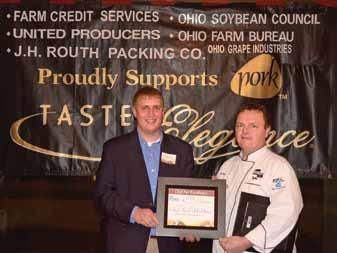
Kevin Flax, OSC board member and soybean farmer from Clark County presents the Chef Par Excellence Award to Chef Todd McDunn, Executive Chef of Lakeview Café at Scott’s Miracle-Gro Co.
Highlighting the event was a competition between some of Ohio’s elite chefs. Chef Todd McDunn, Executive Chef of Lakeview Café at Scott’s Miracle-Gro Co. took top honors at the Ohio Pork Council’s Taste of Elegance chef competition, earning the coveted Chef Par Excellence Award and People’s Choice Award. Chef Michael Koenig, Executive Chef of Latitude 41 in Columbus, was named Superior Chef while Matt Rapposelli, Executive Chef of Hocking Hills Dining
Lodge was selected Premier Chef. Among those in attendance were, Senate President Keith Faber, Speaker of the Ohio House William G. Batchelder, Senate Agriculture Chairman Cliff Hite and Ohio Department of Agriculture Director David Daniels. u

Ohio Soybean Council Foundation Awards 20142015 Scholarship Recipients
By Katie Bauer
The future of Ohio’s soybean industry is dependent on the next generation of thinkers such as undergraduate and graduate students attending Ohio colleges and universities. In fact, agriculture is the leading industry in Ohio with one in every seven jobs related to agriculture. It is for this reason that the Ohio Soybean Council Foundation (OSCF) awards students who are preparing to take on careers in a variety of agriculturally-related fields with scholarships towards their academic endeavors.
Now in its 7th year, the OSCF scholarships were awarded on a competitive basis
Undergraduate Winners
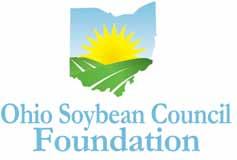
to full-time students enrolled at an Ohio college or university.
Seven undergraduate students were awarded $3,000 scholarships, including the Farmer, Lumpe and McClelland Excellence in Communications Scholarship founded to provide resources to young people with a
passion for agricultural or business communications. An additional $5,000 Bhima Vijayendran Scholarship was awarded and designed to encourage students to pursue majors that lead to future innovations in biobased materials and their commercialization.
In addition to undergraduate scholarships, two graduate students conducting soybean research were awarded $5,000 each.
“I would like to congratulate all of the 2014-2015 OSCF scholarship winners,” said Amy Sigg Davis, Ohio Soybean Council board member and soybean farmer from Warren County who also serves on the scholarship selection committee. “Every year we look forward to seeing what the students will accomplish as they pursue careers in the field of agriculture and make advancements to the soybean industry.”
To learn more about the OSCF scholarship program, visit www.soyohio.org.
Congratulations to the 2014-2015 Ohio Soybean Council Foundation Scholarship Winners!
Graduate Winners
Grace Bluck ($5,000) of Clarksburg, Ohio is pursuing a master’s degree in Horticulture and Crop Science at The Ohio State University. She is currently conducting research in nine locations throughout Ohio while focusing on five differ-
ent management practices to determine which practices lead to higher soybean quality traits and yield.
Brinda Mehta ($5,000) of Cuyahoga Falls, Ohio is pursuing a Ph.D in Polymer Science at the University of Akron. Her
current research focuses on the conversion of plant-based oils such as soybean oil to useful polymers or composites to achieve the mechanical and thermal properties of traditional polymers derived from petroleum-based oils.u

OSC and OSA Update Farmer-focused Website
By Katie Bauer
The Ohio Soybean Council (OSC) and Ohio Soybean Association (OSA) recently launched a new, easy-to-navigate website design
to showcase OSC and OSA news and information. The newly-formatted design houses both OSC and OSA related news stories, farmer-funded projects,
areas of investment, legislative updates and much more. Visit www.soyohio. org to learn more about the two organizations today!


What to expect
1 Check out the updated OSA section and read about recent legislative news, programs, membership benefits, action alerts and state & federal legislative priorities
2 Read about recent farmerfunded projects, return on your investment and the soybean rewards program with posts and information from researchers and industry affiliates
3 Sign up for the latest soybean news delivered right to your inbox using the newsletter sign up tab
4 Click these tabs for direct access to OSC and OSA programs
5 This clickable side box makes it easy to navigate and jump around to different topic areas on the site
6 Learn about the Ohio Soybean Council Foundation Scholarship Program and Science Fair
7 Here you will find stories and information on OSC’s investment areas including soybean research, animal agriculture, global utilization, soy bioproducts & technology, transportation & logistics and freedom to operate u

Investing Checkoff Dollars
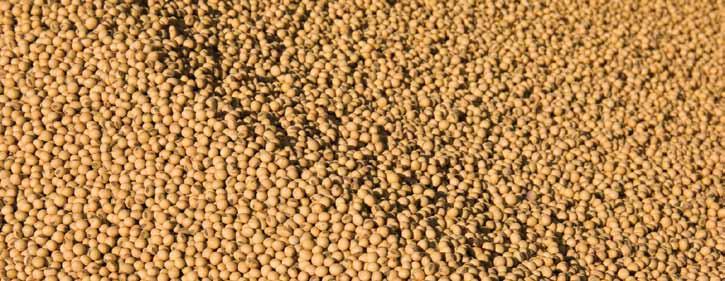
Six Things Farmers Should Know About Seed Treatments
By Paul Spooner
Many farmers may be questioning whether their soybeans need a fungicide seed treatment this planting season. But that depends on many factors – from weather and planting date to drainage and seed costs. And if conditions or field history do not dictate the use of a fungicide seed treatment, then it may not be the best option for you.
The soybean checkoff funds seedtreatment research, providing U.S. soybean farmers with practical production knowledge and helping protect their yields against seedling diseases.
Applying seed treatments is a rapidly growing trend. In fact, the soybean industry estimates that 60 to 70 percent of the 2014 soybean seed planted will have a seed treatment. That’s compared with 30 percent in 2008 and 8 percent in 1996, according to Gary Munkvold, Ph.D., plant pathology and microbiology professor at Iowa State University.
But despite the rise in seed treatment use, it might not be the best option for your operation.
Here are six things to consider:
1 Farmers with poorly drained or no-tilled fields, continuous-soybean or soybeancorn rotations and a history of replanting are the most likely to see the added benefit of using a seed treatment, according to The Ohio State University.
2
When spring conditions are cool and wet and when planting occurs in late April to early May, seed-treatment fungicides are an effective tool, according to Shawn Conley, soybean extension specialist at the University of WisconsinMadison.
3
The use of a seed treatment is most impactful in fields with a history of post-planting problems, such as minor soil crusting, temporary flooding, soil compaction or poorly drained soils, according to the University of Kentucky.
4
Treatments are also useful when farmers use low seeding rates and when farmers plant seed with a moderate
germination rate or when the germination rate is unknown. Using a fungicide treatment on soybean seeds will increase the probability of achieving a satisfactory stand and will enhance the early-season vigor of established seedlings, according to the Mississippi Soybean Promotion Board.
5
With the increase in cost of seed, many farmers don’t want to overplant. As a result, according to Iowa State University and University of WisconsinMadison, some are decreasing their seeding rate and using the money they save on seed treatments instead.
6
Fungicide seed treatments showed an average yield increase of 2.5 bushels per acre over an eight year period, according to Kansas State University Research and Extension.
Always remember to separate treated seed and harvested soybeans to protect the integrity of the U.S. soybean supply. This will avoid putting the U.S. soybean industry’s relationship with customers beyond the elevator in jeopardy. u

Investing Checkoff Dollars
CommonGround Volunteers Discuss Food on Popular Morning Show
CommonGround volunteers recently shared how they grow and raise food for America’s families with the hosts of popular Lifetime TV morning show, “The Balancing Act.” The four-segment miniseries kicked off on Monday, Nov. 25 at 7:00 a.m.
CommonGround is a grass-roots movement to foster conversation among women — on farms and in cities — about where our food comes from. The United Soybean Board (USB) and the National Corn Growers Association (NCGA) developed CommonGround to give farm women the opportunity to engage with consumers through the use of a wide range of activities.
Viewers got the chance to learn from American farm women about:
Understanding Cost of Food in America with CommonGround
Mary Courtney, a Kentucky farmer and CommonGround volunteer, provided a way for moms looking for answers about food to connect with and get real, credible food information from moms who grow and raise it.
“‘The Balancing Act’ provides a great forum to connect with moms across the country and let them know that farmers just like me want to share the story behind how American food is grown and raised,” said Courtney.
Recipes From American Farms To Your Kitchen
Ohio farmer Kristin Reese showed off her cooking skills while teaching viewers about family farms in America. Reese also shared her favorite holiday recipes.
“I am often shocked that many people do not know 96 percent of the farms in America are family-owned and operated,” said Reese. “It was won-

derful to be able to share facts like these with the moms who tuned into national television programs like the ‘The Balancing Act.’”
Food Myths and GMOs
Iowa farmer Sara Ross led the conversation about popular myths surrounding biotechnology, often referred to as GMOs.
“We were thrilled to work with ‘The Balancing Act’ to create television that really dug deep into some of the hottest food topics,” said Ross. “There is such a strong desire here to really delve into every aspect of American food, and, as farmers, we bring a unique perspective on issues like GMOs, organic food and the local food movement to an audience that was hungry to hear from women who share their experience and concerns, but also have first-hand knowledge on these subjects.”
Lifetime Network’s “The Balancing Act” welcomed farmers to discuss popular food and farming issues. Ohio farmer, Kristin Reese (right) shared her favorite holiday recipes and explained that 96% of farms are family-owned and operated. Pictured on the left is Dawn Caldwell, Nebraska farmer and Olga Villaverde, host of “The Balancing Act.”
Understanding How Farmers Raise Healthy Food for Our Families
Nebraska farmer and rancher Dawn Caldwell shared health news viewers could use regarding food safety. Caldwell broke down food-safety myths and gave valuable tips to prepare meat and produce at home.
“People often forget to take the proper safety precautions with food once they get it home,” said Caldwell. “As a farmer dedicated to raising a healthy food supply, I want Americans to also pay attention to how they prepare the food they feed their families.”
More than 400,000 women watch “The Balancing Act” every day, which offered a perfect opportunity for CommonGround to share the truth about food with the women who buy it. For additional information or to view a segment visit www.thebalancingact.com. u
Portions of

Investing Checkoff Dollars
Cold Temperatures and the Potential for Insect Mortality on Soybeans
By Ron Hammond and Andy Michel, Department of Entomology, Ohio Agricultural Research and Development Center, The Ohio
State University
This past winter had two instances of extremely cold temperatures, well below those that are considered normal low temperatures in Ohio. After any cold winter, we get questions as to whether insect mortality might have occurred, and our answer has been that it is usually not cold enough to be a factor in causing significant insect mortality during the winter months. However, the extreme cold this past winter has the potential to change that thought, at least for those pests that overwinter in Ohio. An example of what can happen occurred in the winter of 1983-1984 during an extreme cold spell that caused significant mortality to Mexican bean beetles which had been causing considerable grower concern across Ohio. Since that winter, this insect has never threatened soybean growers except in a few counties in east-central Ohio.
Will growers see similar mortality to the various insects that are a threat to soybeans?
At this time, we can only say it is a possibility; however, we will not be able to tell what happens until we actually see insect
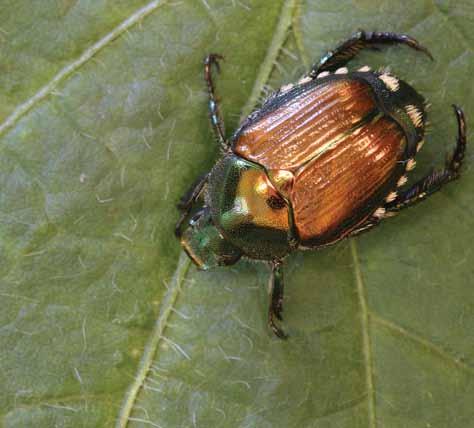
numbers, or the lack of them, during the growing season. The insects that overwinter in our state have a tremendous ability to survive severe conditions, although we are pushing the limit this winter. Insects overwinter in protected places, and growers also need to consider heavier snow cover which is a good insulator.
Which soybean insects fit into this category of overwintering in Ohio that might be affected?
On soybeans, insects or other pests of interest include bean leaf beetles, Japanese beetles, Mexican bean beetles (at least in localized areas), stink bugs, slugs, and the soybean aphid. However, soybean aphids should be considered slightly differently. The main thought is that the aphid has always occurred in a two-year cycle; a high soybean aphid year is followed by a very low year, where aphids are difficult to find in the state, let alone at a level causing concern. Because the past summer of 2013 was a high year, with aphids common on soybeans and at economic levels in many fields, we expect this coming summer to be a low year. We already expect soybean aphids to be at very low to non-existent
The adult Japanese beetle can cause significant defoliation to soybeans. The behavior of the Japanese beetle is unique in that it gives off various pheromones that attract other beetles. Thus, adult Japanese beetles are usually found in masses rather than as single individuals. Because of this aggregating behavior, they are not spread throughout the field like many insects, but usually occur in groups.
levels. Thus, if aphids are indeed lower, will it be because of the two-year cycle, or significant mortality caused by the cold winter? It will be more interesting to see what happens in 2015, a year that should be a high aphid year. If the cold spell we experienced this winter has a negative impact on their populations, perhaps it will be more noticeable the following year.
A specific stink bug should be mentioned, and that is the newest pest of grower concern, the brown marmorated stink bug. It will be interesting to see what happens to this insect following this extreme winter for no other reason than this has been the first “really cold winter” that it has experienced since its introduction into the U.S. Will the insect be able to handle those extremely low temperatures? Or will they suffer significant mortality? We will need to keep close watch this summer to find out the answer. u

OSC Launches Education Website to Grow our Next Generation
By Katie Bauer
For the past 17 years, the Ohio Soybean Council (OSC) and soybean checkoff have been investing in the development of curriculum and educational materials focusing on the science of the soybean and its production, as well as cultivating strong education networks of teachers throughout the state of Ohio. OSC continues to support this investment by launching a new website, GrowNextGen. org, to provide educators with a wide array of relevant classroom materials and direct access to industry partners.
The site was specifically developed to bring real-world situations into the classroom focused on chemistry, biology, biotechnology, environmental science and agriscience.

“Through the development of this interactive website, Ohio soybean farmers have created a centralized location where curriculum, educational materials and future materials can be accessed,” said John Motter, OSC soybean farmer from Hancock County.
In addition to relevant curriculum materials related to soybean production and agriculture, the site also houses career videos, interactive e-learning courses, background information and networking & sharing abilities. The site also includes upcoming workshops and regular communication with teachers to highlight new materials and testimonials.
“When we began the process, we spoke with teachers about what information and resources were out there
to educate students about soybeans, agriculture and the many careers that are available in these fields,” said Amy Sigg Davis, OSC Domestic Marketing Committee Chair and soybean farmer from Warren county.
“Unfortunately, many of those resources needed updating to reflect the realities of farming and food production today. Ohio teachers may be the first
“OSC is proud to prepare Ohio teachers to educate students about soybeans, career opportunities in agriculture and the practice farm families use to grow their food,” said Amy Sigg Davis, OSC Domestic Marketing Committee Chair and soybean farmer from Warren County.
people to talk with students about agriculture and how science is such a big part of what farming and food is all about. We want to offer them the best resources we can.” Go to www. grownextgen.org to learn more about the materials and resources that are helping to connect teachers and their students to Ohio soybeans and agriculture. u


